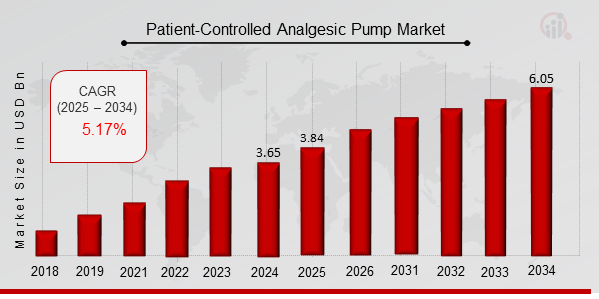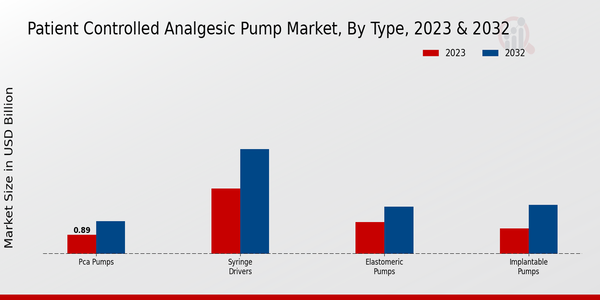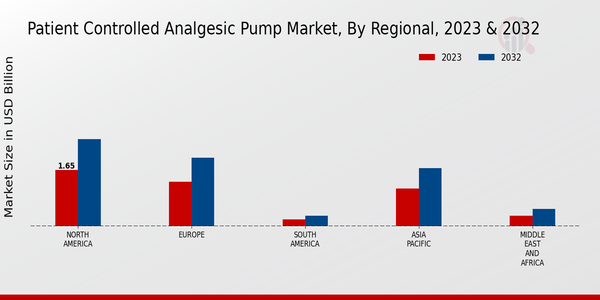Patient-Controlled Analgesic Pump Market Overview
As per MRFR analysis, the Patient-Controlled Analgesic Pump Market Size was estimated at 3.65 (USD Billion) in 2024. The Patient-Controlled Analgesic Pump Market Industry is expected to grow from 3.84 (USD Billion) in 2025 to 6.05 (USD Billion) till 2034, at a CAGR (growth rate) is expected to be around 5.17% during the forecast period (2025 - 2034).
Key Patient-Controlled Analgesic Pump Market Trends Highlighted
The Patient-Controlled Analgesic Pump market is witnessing a surge in demand driven by the increasing prevalence of acute and chronic pain, along with the growing adoption of minimally invasive surgeries. Advancements in technology have led to the development of innovative pumps with enhanced features such as improved pain management, patient safety, and user-friendly interfaces. The adoption of electronic health records (EHRs) and the integration of pumps with hospital networks are further driving market growth. Additionally, the rising awareness of patient-controlled pain management is contributing to the increased adoption of these pumps.

Source: Primary Research, Secondary Research, MRFR Database and Analyst Review
Patient-Controlled Analgesic Pump Market Drivers
Increasing Demand for Pain Management in Acute and Chronic Conditions
The rising prevalence of acute and chronic pain conditions, such as cancer pain, post-operative pain, and chronic musculoskeletal pain, is a major driver of the Global Patient-Controlled Analgesic Pump Market Industry. Patient-controlled analgesia (PCA) pumps provide patients with self-administered pain relief, allowing them to manage their pain levels more effectively. The convenience and efficacy of PCA pumps in pain management settings have contributed to their growing adoption in hospitals, clinics, and other healthcare facilities.
Additionally, the development of advanced PCA pumps with features such as wireless connectivity and remote monitoring capabilities is further enhancing their appeal among healthcare providers and patients alike.
Technological Advancements and Innovation in PCA Pumps
The Global Patient-Controlled Analgesic Pump Market Industry is driven by continuous advancements in technology and innovation. Manufacturers are investing in research and development to introduce PCA pumps with improved features and capabilities. These advancements include the integration of advanced drug delivery systems, enhanced safety mechanisms, and user-friendly interfaces. The incorporation of wireless technology allows for remote monitoring of patient's pain levels and pump settings, enabling healthcare providers to adjust medication delivery remotely and optimize pain management.
Furthermore, the development of PCA pumps specifically designed for specific patient populations, such as pediatric patients or those with cognitive impairments, is expanding the market's reach.
Growing Awareness and Acceptance of PCA Pumps
The increasing awareness and acceptance of PCA pumps among healthcare professionals and patients is a key factor driving market growth. Educational initiatives and training programs have played a significant role in highlighting the benefits of PCA pumps in pain management. Healthcare providers are recognizing the advantages of PCA pumps in reducing patient pain levels, improving patient satisfaction, and enhancing overall recovery outcomes. Patients are also becoming more comfortable with the use of PCA pumps, as they offer greater control over their pain management and reduce the need for frequent nurse interventions.
The growing acceptance of PCA pumps is expected to continue to drive market demand in the coming years.
Patient-Controlled Analgesic Pump Market Segment Insights
Patient-Controlled Analgesic Pump Market Type Insights
Type Segment Insight and Overview The Global Patient-Controlled Analgesic Pump Market is segmented by type into Syringe Drivers, Elastomeric Pumps, PCA Pumps, and Implantable Pumps.
Syringe Drivers: Syringe Drivers are expected to dominate the market with a market share of over 40% in 2024. Their dominance is attributed to their versatility and ability to deliver a wide range of medications, including opioids and non-opioids.
Elastomeric Pumps: Elastomeric Pumps are estimated to hold a significant share of the market owing to their simplicity and cost-effectiveness. They are commonly used for continuous infusion of medications, such as pain relievers and antibiotics.
PCA Pumps: PCA Pumps are projected to exhibit steady growth, gaining a market share of over 35%. These pumps provide patients with greater control over their pain management, allowing them to self-administer pain medication when needed.
Implantable Pumps: Implantable Pumps are expected to experience the fastest growth in the coming years, with a market share of over 15%. These pumps offer long-term pain relief and are used for chronic pain conditions, such as cancer pain and intractable pain.
The increasing prevalence of chronic pain conditions, rising demand for effective pain management, and technological advancements are key factors driving the growth of the Patient-Controlled Analgesic Pump Market. The market is expected to witness significant growth in the coming years, with a CAGR of over 5% during the forecast period of 2024-2030.

Source: Primary Research, Secondary Research, MRFR Database and Analyst Review
Patient-Controlled Analgesic Pump Market Application Insights
The Global Patient-Controlled Analgesic Pump Market is segmented into various applications, including Postoperative Pain Management, Cancer Pain Management, Labor Pain Management, Trauma and Emergency Pain Management, and Other Applications. Among these, Postoperative Pain Management held the largest market share in 2023 and is expected to continue its dominance throughout the forecast period. The rising prevalence of surgical procedures, increasing demand for pain management solutions, and technological advancements in patient-controlled analgesic pumps drive the growth of this segment.
Cancer Pain Management is another significant application segment, with a growing number of cancer patients requiring effective pain management strategies.
Labor Pain Management is also expected to witness steady growth due to the increasing preference for non-invasive pain relief methods during childbirth. Trauma and Emergency Pain Management is another important segment driven by the rising incidence of accidents and emergencies. Other Applications, including the management of chronic pain conditions, are also expected to contribute to the overall market growth in the coming years.
Patient-Controlled Analgesic Pump Market End User Insights
The Global Patient-Controlled Analgesic Pump Market Segmentation by End User includes Hospitals, Ambulatory Surgical Centers, Pain Management Clinics, Home Healthcare Settings, and Other End Users. Hospitals dominate the market owing to the high volume of surgeries performed in these settings and the need for effective pain management. Ambulatory Surgical Centers are projected to witness significant growth due to the increasing number of same-day surgeries. Pain Management Clinics are also expected to contribute to market growth as they offer specialized pain management services.
Home Healthcare Settings are gaining traction as patients prefer to recover in the comfort of their homes. The "Other End Users" segment includes clinics, nursing homes, and hospice care facilities.
Patient-Controlled Analgesic Pump Market Technology Insights
The Global Patient-Controlled Analgesic Pump Market is segmented by Technology into Conventional Patient-Controlled Analgesia (PCA) Pumps, Ambulatory Patient-Controlled Analgesia (APCA) Pumps, Wireless Patient-Controlled Analgesia (WPCA) Pumps, and Other Technologies. In 2023, the Conventional PCA Pumps segment held the largest market share, accounting for over 55% of the Global Patient-Controlled Analgesic Pump Market revenue. This is due to the widespread adoption of these pumps in hospitals and ambulatory surgical centers.
However, the APCA Pumps segment is expected to grow at the fastest CAGR during the forecast period, owing to the increasing demand for pain management in home settings.The WPCA Pumps segment is also expected to witness significant growth, driven by the rising adoption of wireless technologies in healthcare. The other Technologies segment includes emerging technologies such as wearable PCA pumps and smartphone-controlled PCA pumps, which are expected to gain traction in the coming years.
Patient-Controlled Analgesic Pump Market Regional Insights
The regional segmentation of the Global Patient-Controlled Analgesic Pump Market offers valuable insights into market dynamics and opportunities. North America emerged as the dominant regional market in 2023, capturing a significant share of global revenue due to the high adoption of advanced healthcare technologies and a large patient population suffering from chronic pain. Europe follows closely behind, driven by supportive government policies and a well-established healthcare infrastructure.
The APAC region is anticipated to experience the highest growth rate over the forecast period, owing to rising disposable income, increasing healthcare expenditure, and a growing elderly population.South America and MEA represent emerging markets with untapped potential, offering growth opportunities for manufacturers. Regional market analysis provides crucial information for businesses to tailor their strategies, optimize resource allocation, and capitalize on specific growth areas.

Source: Primary Research, Secondary Research, MRFR Database and Analyst Review
Patient-Controlled Analgesic Pump Market Key Players And Competitive Insights
Major players in the Patient-Controlled Analgesic Pump Market industry are continuously focusing on improving product quality, investing in the latest technologies, and expanding their market reach. Continuous developments in the Patient-Controlled Analgesic Pump Market industry, such as the rising adoption of advanced technologies and the introduction of new products, are shaping the competitive landscape. Leading Patient-Controlled Analgesic Pump Market players are actively engaged in research and development activities to bring innovative products to the market and enhance their technological edge. Merger and acquisition strategies, as well as collaborations and partnerships, are also important factors driving Patient-Controlled Analgesic Pump Market development.
Smiths Medical's focus on expanding its patient-centric solutions and improving patient outcomes has contributed to its leading position in the Patient-Controlled Analgesic Pump Market. The company's dedication to innovation and developing technologically advanced products has enabled it to maintain its competitive edge. Smiths Medical's extensive product portfolio caters to a wide range of patient needs, including those requiring pain management, respiratory care, and anesthesia. This diverse product offering has solidified the company's position as a key player in the Patient-Controlled Analgesic Pump Market.
Medtronic's commitment to developing innovative and reliable patient care solutions has positioned it as a strong competitor in the Patient-Controlled Analgesic Pump Market. The company's focus on investing in research and development has resulted in the introduction of advanced products that meet the evolving needs of healthcare providers. Medtronic's strong brand recognition and global presence allow it to reach a wide customer base, contributing to its success in the Patient-Controlled Analgesic Pump Market. The company's commitment to delivering high-quality products and continuous innovation has enabled it to maintain a competitive advantage in this dynamic market.
Key Companies in the Patient-Controlled Analgesic Pump Market Include
- Johnson Johnson
- Fresenius Kabi AG
- Baxter International
- Cardinal Health
- Stryker
- Boston Scientific
- Epimed International
- Terumo Corporation
- Medtronic
- Halyard Health
- Smiths Medical
- ICU Medical
- Braun Melsungen AG
- Shenzhen Mindray BioMedical Electronics
- Teleflex Incorporated
Patient-Controlled Analgesic Pump Market Industry Developments
The global Patient-Controlled analgesic pump market is anticipated to grow at a steady pace over the forecast period. Key factors driving market growth include increasing demand for pain management, technological advancements, and supportive government initiatives. Major players in the market are focusing on strategic acquisitions and partnerships to expand their portfolios and strengthen their market position.For instance, in January 2023, Smiths Medical, a global medical device company, acquired Medfusion, a leading provider of infusion and pain management solutions. This acquisition is expected to bolster Smiths Medical's product offerings and enhance its presence in the Patient-Controlled analgesic pump market.
Additionally, the market is witnessing a surge in the adoption of wireless and ambulatory Patient-Controlled analgesic pumps, which provide greater patient comfort and mobility. These pumps offer remote monitoring capabilities, allowing healthcare providers to track patient progress and adjust medication delivery remotely. This trend is anticipated to contribute to the growth of the Patient-Controlled analgesic pump market in the coming years.
Patient-Controlled Analgesic Pump Market Segmentation Insights
Patient-Controlled Analgesic Pump Market Type Outlook
- Syringe Drivers
- Elastomeric Pumps
- PCA Pumps
- Implantable Pumps
Patient-Controlled Analgesic Pump Market Application Outlook
- Postoperative Pain Management
- Cancer Pain Management
- Labor Pain Management
- Trauma and Emergency Pain Management
- Other Applications
Patient-Controlled Analgesic Pump Market End User Outlook
- Hospitals
- Ambulatory Surgical Centers
- Pain Management Clinics
- Home Healthcare Settings
- Other End Users
Patient-Controlled Analgesic Pump Market Technology Outlook
- Conventional Patient-Controlled Analgesia (PCA) Pumps
- Ambulatory Patient-Controlled Analgesia (APCA) Pumps
- Wireless Patient-Controlled Analgesia (WPCA) Pumps
- Other Technologies
Patient-Controlled Analgesic Pump Market Regional Outlook
- North America
- Europe
- South America
- Asia Pacific
- Middle East and Africa
| Report Attribute/Metric |
Details |
|
Market Size 2024
|
3.65 (USD Billion)
|
|
Market Size 2025
|
3.84 (USD Billion)
|
|
Market Size 2034
|
6.05 (USD Billion)
|
|
Compound Annual Growth Rate (CAGR)
|
5.17 % (2025 - 2034)
|
|
Report Coverage
|
Revenue Forecast, Competitive Landscape, Growth Factors, and Trends
|
|
Base Year
|
2024
|
|
Market Forecast Period
|
2025 - 2034
|
|
Historical Data
|
2020 - 2024
|
| Market Forecast Units |
USD Billion |
| Key Companies Profiled |
Johnson Johnson, Fresenius Kabi AG, Baxter International, Cardinal Health, Stryker, Boston Scientific, Epimed International, Terumo Corporation, Medtronic, Halyard Health, Smiths Medical, ICU Medical, B. Braun Melsungen AG, Shenzhen Mindray BioMedical Electronics, Teleflex Incorporated |
| Segments Covered |
Type, Application, End User, Technology, Regional |
| Key Market Opportunities |
Rising demand for post-surgical pain management technological advancements expanding geriatric population increasing incidence of chronic pain and government initiatives to improve healthcare infrastructure |
| Key Market Dynamics |
Increased incidence of chronic pain Technological advancements Rising healthcare expenditure Growing geriatric population Expanding prevalence of cancer |
| Countries Covered |
North America, Europe, APAC, South America, MEA |
Frequently Asked Questions (FAQ) :
The Global Patient-Controlled Analgesic Pump Market is projected to reach USD 3.3 billion in 2023.
The Global Patient-Controlled Analgesic Pump Market is expected to reach USD 6.05 billion by 2034.
The Global Patient-Controlled Analgesic Pump Market is expected to grow at a CAGR of 5.17% from 2025 to 2034.
North America is expected to hold the largest market share in the Global Patient-Controlled Analgesic Pump Market in 2023.
Post-operative pain management is expected to hold the largest market share in the Global Patient-Controlled Analgesic Pump Market in 2023.
Key competitors in the Global Patient-Controlled Analgesic Pump Market include Medtronic, Becton, Dickinson and Company, Smiths Medical, and Baxter International.
Key growth drivers of the Global Patient-Controlled Analgesic Pump Market include increasing demand for pain management, technological advancements, and rising healthcare expenditure.
Key challenges of the Global Patient-Controlled Analgesic Pump Market include stringent regulatory approvals, reimbursement issues, and competition from alternative pain management therapies.
Key opportunities in the Global Patient-Controlled Analgesic Pump Market include expanding applications in chronic pain management, technological advancements, and increasing awareness of patient-controlled analgesia.
Key trends in the Global Patient-Controlled Analgesic Pump Market include increasing adoption of wireless and wearable devices, integration with electronic health records, and personalized pain management.

















